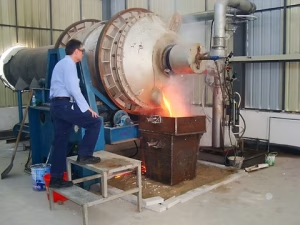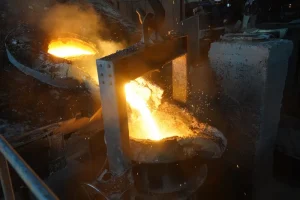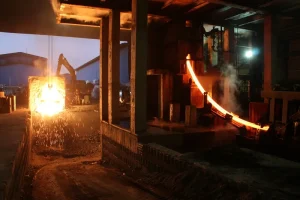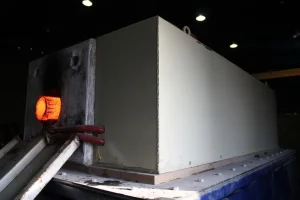In the industrial world, choosing the right method for melting and heating metals plays a key role in productivity, product quality, and energy consumption. Two methods in this field are induction furnaces and fossil fuel furnaces. In this article, we introduce induction furnaces to gain a better understanding of their applications, advantages, and limitations.
Induction Furnaces vs. Fossil Fuel Furnaces
Fossil fuel furnaces have long been used in various industries, especially for metal melting. These furnaces operate using natural gas, diesel, or heavy fuel oil (mazut), providing the required heat through direct combustion. Although starting up and using these furnaces is relatively simple, they have significant drawbacks. Among the most important disadvantages are their low thermal efficiency, high energy loss, limited temperature control, and environmental pollution due to the emission of greenhouse gases such as carbon dioxide and nitrogen oxides.
In addition, the high consumption of fossil fuels in these furnaces leads to increased operational costs and dependency on non-renewable energy sources.

Induction furnaces are a type of electric furnace that operate based on electromagnetic induction. In these furnaces, a coil is connected to an alternating current (AC) power source, generating a varying magnetic field around it. When a conductive material such as metal is placed within this field, eddy currents are induced in the metal. Due to the electrical resistance of the metal, these currents generate heat, eventually leading to the melting of the material. Heating in induction furnaces occurs without direct contact and without an open flame, resulting in uniform heat distribution and reduced environmental pollution.

History of Induction Furnaces
Hans Christian Ørsted, a Danish physicist (1777–1851), discovered that an alternating magnetic field is formed around a wire carrying alternating electric current. This significant discovery marked the beginning of a journey that was later completed by scientists such as Michael Faraday (1791–1867) and James Clerk Maxwell (1831–1879), eventually leading to the development of Faraday’s Laws and Maxwell’s Equations.
In short, the discovery, analysis, and understanding of the relationship between electricity and magnetic fields opened a new gateway to the world. These relationships not only allowed us to better understand and analyze many natural phenomena but also enabled the creation of new devices and technologies.
Modern humans pass by devices like electric motors, transformers, induction furnaces, and thousands of other inventions so casually—as if they’ve existed since the dawn of time—while history shows that today’s world and its conveniences are indebted to the curiosity, hard work, and self-sacrifice of countless scientists. Each of them, whether their life was long or short, has left a mark in the pages of history.
A brief look at history shows the evolution of science and the invention of several practical products without which our world today would be completely different:
- The invention of the battery by Alessandro Volta, 1800
- The discovery of the magnetic field around a current-carrying conductor by Ørsted, 1820
- Faraday’s Law, 1831
- The invention of the induction motor by Peter Barlow, 1834
- The invention of the transformer by William Stanley, 1885
- The invention of the induction furnace by Edward Allen Colby, 1900
Although modern induction furnaces are designed and manufactured with advanced technologies, the concept of induction heating dates back more than a century. The physical principles of electromagnetic induction were discovered by Michael Faraday in the late 19th century, and the first primitive induction furnace models were built in the early 20th century. In the 1920s, these furnaces gradually entered industrial use for melting metals in limited capacities. With advancements in power supply and electronic control technologies—especially after the 1950s—induction furnaces gained increasing importance in metallurgy and foundry industries.
Types of Induction Furnaces
Induction furnaces are generally divided into two main categories: induction melting furnaces and induction heat treatment furnaces. Induction melting furnaces are used to melt metals such as steel, cast iron, aluminum, and copper. They typically feature a crucible where the metal is placed and heated by a magnetic field. These furnaces come in various capacities and are widely used in foundries and steelmaking industries. Applications of Induction Furnaces
Induction furnaces are generally divided into two main categories: induction melting furnaces and induction heat treatment furnaces. Induction melting furnaces are used to melt metals such as steel, cast iron, aluminum, and copper. They typically feature a crucible where the metal is placed and heated by a magnetic field. These furnaces come in various capacities and are widely used in foundries and steelmaking industries. Applications of Induction Furnaces
Induction furnaces are produced in a wide range of sizes and capacities to meet various industrial needs. Their capacity can range from a few kilograms for laboratory use or small-scale part manufacturing, to several tons for large-scale steel and foundry industries. In terms of electrical power, they also cover a broad spectrum; some small furnaces operate at just one or two kilowatts, while large industrial furnaces may consume tens of megawatts. Choosing the appropriate capacity and power depends on factors such as the type of metal, the required melting speed, and the specific application.

Application of Induction Furnaces in Alloy Production
In the production of alloy steels and special alloys, the use of induction melting furnaces offers a significant advantage due to their controllable features. One of the main reasons for this advantage is the indirect, flame-free heating, which minimizes the risk of contaminating the molten metal with harmful gases or impurities from fossil fuels. Additionally, induction furnaces allow for precise control over temperature and melting time, which is essential for accurately combining alloying elements such as chromium, nickel, molybdenum, or vanadium. The absence of oxygen and direct combustion reduces oxidation rates, which is crucial for maintaining the desired chemical composition of alloys.
Heat Treatment with Induction Furnaces
Induction heat treatment furnaces are used in various processes including annealing, hardening, tempering, and normalizing.
Annealing is a process in which a metal part is heated to a specific temperature and then slowly cooled to soften its crystalline structure, reduce internal stresses, and improve machinability or formability.
Hardening involves rapidly heating the surface of a part and then suddenly cooling it (e.g., with water or oil) to harden the surface and increase wear resistance.
Tempering refers to reheating a hardened part to a temperature lower than the hardening temperature in order to reduce brittleness.
Normalizing involves heating the part to a high temperature and then allowing it to cool in open air, which helps to refine the grain structure and enhance mechanical properties.
These processes, using precise and controlled induction heating, can be applied to specific areas of the part without the need to heat its entire volume.


